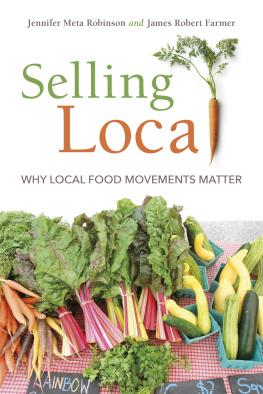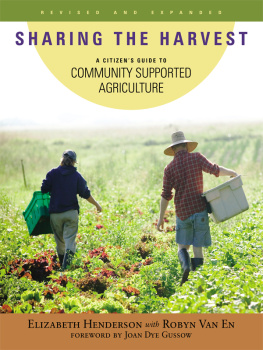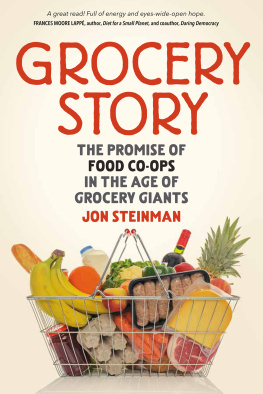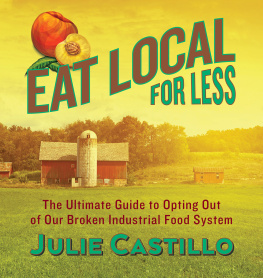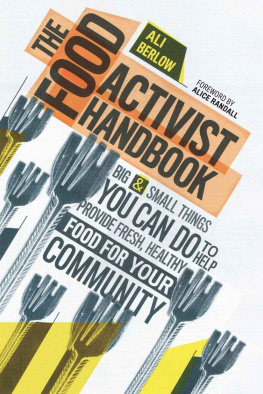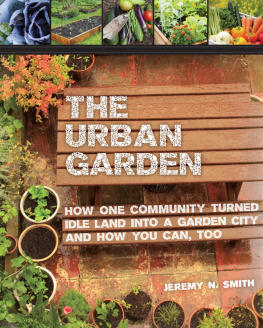
Selling Local
Jennifer Meta Robinson and James Robert Farmer
Selling Loca
WHY LOCAL FOOD MOVEMENTS MATTER
INDIANA UNIVERSITY PRESS
This book is a publication of
Indiana University Press
Office of Scholarly Publishing
Herman B Wells Library 350
1320 East 10th Street
Bloomington, Indiana 47405 USA
iupress.indiana.edu
2017 by Jennifer Meta Robinson and James R. Farmer
All rights reserved
No part of this book may be reproduced or utilized in any form or by any means, electronic or mechanical, including photocopying and recording, or by any information storage and retrieval system, without permission in writing from the publisher. The Association of American University Presses Resolution on Permissions constitutes the only exception to this prohibition.
The paper used in this publication meets the minimum requirements of the American National Standard for Information SciencesPermanence of Paper for Printed Library Materials, ANSI Z39.481992.
Manufactured in the United States of America
Library of Congress Cataloging-in-Publication Data
Names: Robinson, Jennifer Meta, [date], author. | Farmer, James R. (James Robert), author.
Title: Selling local : why local food movements matter / Jennifer Meta Robinson and James R. Farmer.
Description: Bloomington, Indiana : Indiana University Press, [2017] | Includes bibliographical references and index.
Identifiers: LCCN 2017004284 (print) | LCCN 2017007339 (ebook) | ISBN 9780253026989 (pb : alk. paper) | ISBN 9780253027092 (eb)
Subjects: LCSH: Local foodsUnited States. | Farmers marketsUnited States. | Community-supported agricultureUnited States.
Classification: LCC HD9005 .R63 2017 (print) | LCC HD9005 (ebook) | DDC 381/.41dc23
LC record available at https://lccn.loc.gov/2017004284
12345222120191817
For
Jeff Hartenfeld, a farmer
Sara, Samuel, Caroline, and Collin Farmer
Eating is an agricultural act.
Wendell Berry
CONTENTS
ACKNOWLEDGMENTS
We thank, foremost, the many farmers and patrons of local food who have shared their time and expertise with us in conversations across the country, at local markets and farms and throughout numerous research projects. We appreciate your observations and thoughtfulness about the journey so far, knowing that life continues to emerge in surprising ways. Special thanks to the people of south-central Indiana and Huntington, West Virginia, for extending their worlds to us. We thank Justin Rawlins for his thoughtful editorial assistance and manuscript preparation and Kevin Naaman for his help with sources. Thanks to Sarah Mincey for essential consultation on theory and Sara Minard, Bridget Masur, Natalie Woodcock, Eric Knackmuhs, Angela Babb, and Megan Betz for able research assistance. Thanks to Sobremesa Farm, Evening Song Farm, and Joseph Donnermeyer for sharing maps and images. Thanks to Steven McFadden for sharing his history of CSAs. Jennifer Roebuck and Dan Schlapbach were generous, as always, with wonderful photographs and good advice.
We are grateful for research funding from Indiana Universitythe College of Arts and Sciences; the Department of Recreation, Park, and Tourism Studies; the School of Public Health; and the Vincent and Elinor Ostrom Workshop in Political Theory and Policy Analysisas well as the Indiana Clinical and Translational Sciences Institute, the Indiana State Department of Agriculture, and the United States Department of Agriculture.
We appreciate the faith Gary Dunham and Indiana University Press have placed in the project. Garys clear-sightedness about salient audiences has helped guide the book to this final form. Thanks to Nancy Lightfoot for shepherding the project and to Jill R. Hughes for her clarifying copyediting.
From Jennifer
Many thanks to Bobbi, Rosie, J. D., Grant, and Farmers Anonymous for letting me listen inyou know who you are! Appreciation to the members of Indiana University Faculty Writing Groups and to Mary Magoulick for writing companionship. And thanks, as always, to Jeff Hartenfeld for helping me keep it real.
From James
Thanks to several farmers who are always willing to listen, critique, and explainTim Alexander, Rick Dalessandro, Lance Alexanderand to Tony Terhaar. And thank you to Jennifer, for her constant mentorship and teaching.
INTRODUCTION
After decades of wanting food in greater quantities, cheaper, and standardized, Americans now increasingly look for quality and crafting. Grocery giants like Walmart and Target have responded by offering simple and organic food displayed in folksy crates with seals of organizational approval, while only blocks away a farmer may drop his tailgate on a pickup full of sweet corn at a four-way stop. Meanwhile, easy-up tents are likely to unfurl over multigenerational farmers markets once or twice a week in any given city or town. No longer peopled by women and old men, markets see sons shopping with their fathers as mother and daughter farmers share produce stands while buskers, students, political activists, photographers, and journalists ply their arts in the aisles. Ostrich, bison, goat, mutton, and every cut of the familiar chicken, pork, and beef come with dazzling endorsements of their local provenance: free-range, cage-free, local, non-GMO, grass-fed, heirloom, biodynamic, natural, organic, community-supported, cooperative, nonprofit. Mac n cheez out of a box may still taste like home cooking to some, and canned-soup casserole may be the pinnacle of culinary adventurousness for others, but chances are, even someone who grew up on those mid-century delicacies is changing what she or he wants to eat and where it comes from.
This book is about is about local food and why it matters. Food organizes our relationship to the world in important ways. Eating is an agricultural act, says Wendell Berry,
This book is about both the idea of selling localits appeal and promiseand the practical ways that gets done in the dynamic context of the twenty-first century. As the pieces come into focus, we can understand foods special capacity to blur distinctions between producers and consumers and to expand our sense of global citizenship. The responsibility for food that is healthful, just, and environmentally sound becomes a shared responsibility of an integrated world.
Trends
Country music superstar Willie Nelson once commented that growing up poor in Texas during the Great Depression meant local food was all they had to eat. True enough. For millennia, people ate mostly what was available to handfresh, stored, and traded. However, with the mass production of industrialization and improvements in transportation during the nineteenth and twentieth centuries, food production and consumption became centralized, homogenous, and fragmented. As cities expanded, farms were forced outside of population centers. In the 1920s, grocery stores replaced produce markets in major cities. At mid-century, womenthe conventional home cooksincreasingly worked outside the home, and convenience became the watchword of food preparation: one-ingredient cakes, TV dinners, frozen vegetables that cooked right in the plastic bag. Improvements in refrigeration and shipping meant we could get pineapples jet fresh from Hawaii and tea and oranges that come all the way from China as a popular Leonard Cohen song put it. Soon, we thought, entire meals would come in pill form.
One popular way to tell the story of the local revolution is that Americans started taking food back around the time Alice Waters created a restaurant in Berkeley, California, that sourced its ingredients from its own garden. That was in 1971. Now restaurants go so far as to feature locally grown, locally ground polenta served in handmade bowls thrown by a nearby potter. Neighborhood potluck dinners, too,
Next page
